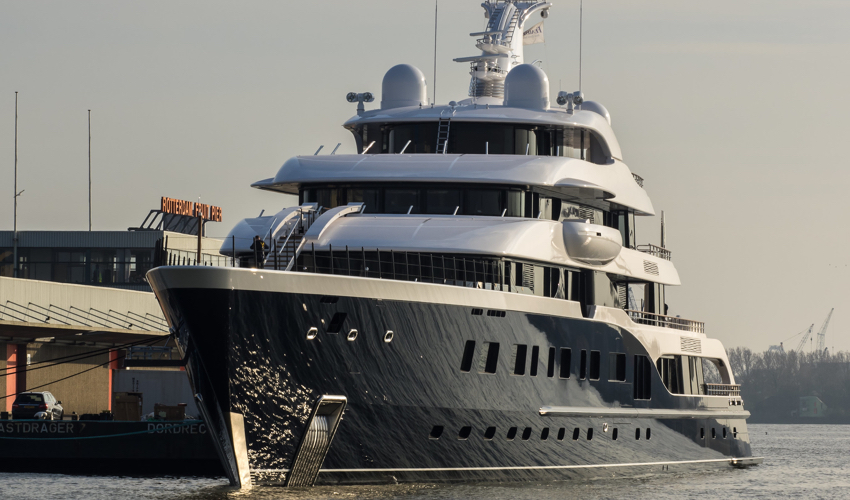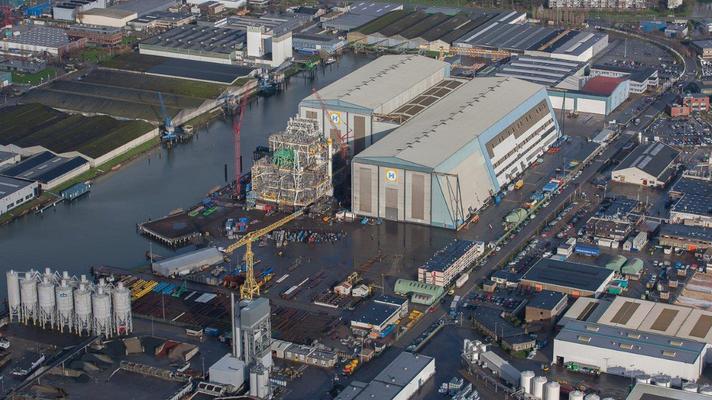They are not the most productive in numbers of yachts, but in a world where the rich are getting richer, what matters is the ability to distinguish yourself from others. With a yacht from a Dutch yard you can. An overview of the Dutch yacht building landscape.
It will cost you, but as an owner of a Dutch superyacht you possess something exclusive. And in that field of competition, the Dutch builders of superyachts definitely deliver. The last few years, the Dutch superyacht industry saw some significant investments in more and larger production sites and refit facilities.
One of the absolute highlights of this year for the superyacht industry was of course the opening by Her Majesty Queen Máxima of the new yard of Royal Van Lent in the Port of Amsterdam on 16 May. Royal Van Lent from Kaag Island has been a member of the Feadship Group since 1949. The other partners are Koninklijke De Vries Scheepsbouw from Aalsmeer and De Voogt Naval Architects from Haarlem. Feadship originally stood for “First Export Association of Dutch Shipbuilders” and was founded to conquer the American market that was booming at the end of the forties.
Van Lent can now build yachts of up to 160 metres
The new yard at the Amsterdam Basisweg is 170 metres long. This enables Van Lent to build yachts of up to 160 metres or receive them for refits. At Kaag Island, the construction of ever bigger yachts becomes more and more difficult as the connection with the sea is through a lengthy (Kaag Island-Maasmond measures ninety kilometres), winding and narrow route of waterways. The largest yacht built at Kaag Island was the 102-metre Symphony.

The 102-metre Symphony is the largest yacht built at Kaag Island (picture by Frans Berkelaar).
The Biggest Yachts
Nowadays, Koninklijke De Vries Scheepsbouw builds its biggest yachts at a yard in Frisian Makkum, where the superyacht Anna (110 metres) was constructed last year. A new yard capable of building and receiving ships up to 160 metres long is a huge step in capacity and brings Feadship in the highest class of yards that build the biggest superyachts. These include for example Lürssen (Bremen), Blohm + Voss (Hamburg) and Nobiskrug (Rendsburg), that deliver yachts of up to 180 metres.
The new Amsterdam yard offers work to in between 200 and 400 people. In part, these will come from the other existing Feadship-yards, but Van Lent plans to find at least some 150 new employees. In an interview with “Het Financieele Dagblad”, Van Lent CEO Jan-Bart Verkuyl emphasises the economic impact on the region as co-makers of the yard will have to hire more staff as well. New staff that Van Lent is looking for are for example engineers, furniture makers, metalworkers, welders, painters and interior decorators. The Feadship Group offers work to around 2500 people.
Van Lent plans to find at least some 150 new employees
Second Amsterdam Yard
Another highlight for the Dutch superyacht industry this year when talking about facilities, was the signing of a contract on 14 May between the Port of Amsterdam and another renowned Dutch yacht builder: Royal Huisman from Vollenhove. With the contract, the Port of Amsterdam leases the former yard of Holland Jachtbouw in Zaandam to Royal Huisman for twenty years. Huisman is the Dutch specialist yacht builder in custom built sailing and motor yachts. The company’s biggest yacht until now had a length of ninety metres. One of the yachts built by Royal Huisman for example, is the world’s longest aluminum sailing yacht of 81 metres for an Asian client.
The establishment of Royal Huisman fits perfectly in the aspiration of the Port of Amsterdam to become an international hub for newbuilding, refitting and servicing of superyachts. And just like Royal Van Lent on Kaag Island, Royal Huisman in Vollenhove encountered more and more problems with access to deep water including having to pass four bridges. Sailing yachts in particular often have deep keels and as a result, Royal Huisman’s bigger yacht projects often had to be finalised at other locations that had to be rented.
Perfect Connections
With the new facility in Zaandam, which borders the Port of Amsterdam, Royal Huisman now has all the necessary access to deep water and a direct connection to the North Sea. With their yards in Amsterdam, the Dutch superyacht builders and all their co-makers and suppliers offer a perfect connection for their clients via the airport of Amsterdam-Schiphol and with Amsterdam and its surroundings an interesting place to pass some time.
Oceanco has plans for building yachts of 140 metres long
Royal Huisman expects to grow its workforce in Zaandam/Amsterdam to between fifty and 75 people, including those from partners and suppliers. Royal Huisman has a filled order book until 2022. It is currently working on three newbuild projects and nine refits.
The third major expansion of facilities of the Dutch superyacht industry is of course the acquisition by Oceanco of the former yard of Heerema Fabrication Group in Zwijndrecht. This facility with two big construction halls and quays at deep water, was closed at the end of last year by the Heerema Group due to lack of work. The company has its headquarters in Alblasserdam and wants to use the new location for the construction of hulls and maintaining and refitting of existing yachts.

Former Heerema facilities in Zwijndrecht (picture by Heerema Fabrication Group).
With the takeover of this facility, Oceanco also anticipates on a growing demand for bigger yachts. With a length of 110 metres, Oceanco has already built the biggest yacht in the Netherlands and is currently building a yacht of 125 metres long. Moreover, according to insiders, it has plans for building yachts of 140 metres long. So just like Feadship, Oceanco is also applying for a ranking in the class of the real megasuperyachts that has so far been dominated by the Germans.
A strong reputation can help you get back up again
Relaunch Moonen
Other news facts that are worth mentioning is the investment Heesen Yachts from Oss did in expanding its interiors production facility in Winterswijk, about which you can read more in the special article about Heesen in our September issue. At the same time, Moonen Yachts from ‘s-Hertogenbosch has proved that a strong reputation can help you get back up again, even when encountering financial difficulties when your original owners pull out.
On 11 July, Moonen was declared bankrupt, but just a month later on 17 August, Moonen could report that it has new Australian owners with whom the yard can be relaunched. Moonen specialises in the market of thirty- to fifty-metre yachts. And although it did not report anything special, Damen’s superyacht branch – Amels in Vlissingen – is steadily expanding its facilities. At this moment, Amels has no less than sixteen projects on order.
A Golden Year
The quick relaunch of Moonen is just more proof that the Dutch superyacht industry is at this moment a very healthy business. At the beginning of May, the trade organisation of the Dutch superyacht industry, Hiswa Holland Yachting Group, reported that 2019 will become a Golden Year for superyacht builders. Right now, the Dutch yards have no less than sixty yachts under construction. Of those sixty are thirteen longer than eighty metres. And 2019 is far from finished, so there could still be some nice orders to come.
Amels has no less than sixteen projects on order
At the end of last year, the Dutch superyacht builders had 4.1 billion euros on order. According to Hiswa, the Dutch superyacht builders now have a market share of 32 per cent in the segment of yachts over thirty metres. The average value of a Dutch superyacht is around 86 million euros. That is thirty million more than a year earlier. The Dutch superyacht industry takes advantage of a very strong reputation in delivering its yachts on time as well as guaranteeing a high quality.
National and International Rankings
For a long time, the top five of the Dutch superyacht industry has consisted of Feadship, Heesen, Amels-Damen, Oceanco and Royal Huisman. According to SuperYacht Times, a Dutch intelligence company in this industry, there are about 600 Dutch-built superyachts of more than thirty metres in operation today. In the segment of over sixty metres, the Dutch yards are the biggest.
The Italians (Azimutti-Benetti, Feretti Group, Sanlorenzo, Overmarine, Palumbo, Baglietto, The Italian Sea Group, Cantiere delle Marche), British (Princess yachts and Sunseeker) and Americans (Alexander Marine and Viking Yachts) produce more yachts, but these are on average smaller. In the top twenty ranking of superyacht builders for 2019 compiled by Boat International, Feadship has position nummer five, just before Amels-Damen on seventh place, followed by Heesen coming in tenth.
When looking at the data gathered by SuperYacht Times, if one counts the yachts that have been built in the last twenty years, with eighty yachts, Feadship is the Dutch number one, followed by Heesen Yachts with 77 yachts, Amels with 49 yachts, Oceanco with 26 and Royal Huisman with 22. In length, the ranking is the same. Only in total volume measured in gross tonnage Feadship is by far the biggest, followed by Oceanco that builds only big ships, Amels-Damen takes the third position and Heesen Yachts the fourth. Royal Huisman’s sailing yachts are mostly smaller and lighter. Yet, for all the superyacht builders it is important to note that their latest orders are for bigger and longer yachts.
Picture (top): Royal Huisman is building a 81-metre three-masted schooner, called Project 400. This will be the world’s largest aluminium sailing yacht (picture by Royal Huisman).








